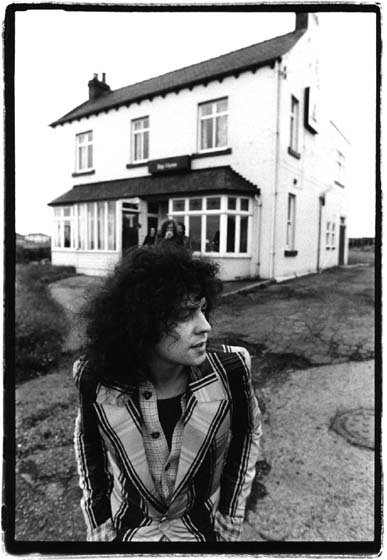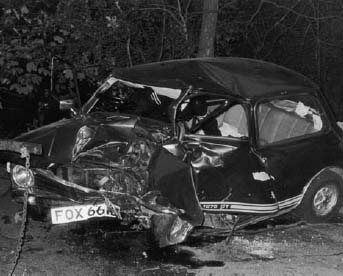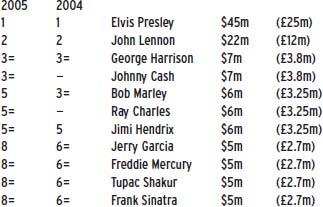The Encyclopedia of Dead Rock Stars (50 page)
Read The Encyclopedia of Dead Rock Stars Online
Authors: Jeremy Simmonds

The figure was greater again in 2006, with the reissue of all of Presley’s British number-one singles the previous year. However, the death of Michael Jackson
(June 2009)
blew everyone out of the water, the singer’s estate earning more in the following year than the rest of the Top Ten
combined.
Source:
Forbes.com
SEPTEMBER
Saturday 3
Keith Harwood
(c 1940)

Whether recording engineers can truly be legendary is perhaps a matter for debate, but London Olympic Studios wizard Keith Harwood – the man behind timeless recordings by David Bowie, Led Zeppelin, Humble Pie, The Pretty Things and Mott the Hoople – was considered so by many. His best-known work was probably the slew of albums he made with The Rolling Stones during the seventies; indeed his last sessions before he died had been on ‘Love You Live’ (spring, 1977), a concert recording that The Stones eventually dedicated to Harwood’s memory. A further irony was that Harwood was on his way back from Olympic when his car hit the same South London tree that was to claim a much bigger name less than two weeks later …

Marc Bolan: His people were fair and lived in his hair; (opposite) T Wrecks?
Friday 16
Marc Bolan
(Mark Feld - Hackney, London, 30 September 1947)
T Rex/TyrannosaurusRex
(John’s Children)

‘I’ll see you next week … same Marc time … same Marc channel!’ The kitsch vernacular of his Granada TV pop show was indicative more of the desperation of his publicity department than of the charisma of Marc Bolan himself. Its pre-primetime slot was also a measure of how far the former idol had descended since his heady days at the start of the decade. However, it was not the budget television series that was to relaunch interest in Bolan; fate saw to it that any further success was to be posthumous. As a memorably impromptu edition fooling with old pal David Bowie aired, fans were already aware that there’d be no ‘Marc time’ next week – and the day’s papers were publishing images of the mangled wreckage of his car being disentangled from a sycamore tree on Barnes Common.
Bolan
had
been a genuine star, of that there’s no argument. Aside from Bowie’s brief (if enduring) foray into the genre, T Rex represented the real talent in premier-league glam rock, artistically head and shoulders above the Slades, Sweets and Gary Glitters with whom they regularly rubbed shoulders at the business end of the UK hit parade. Having ditched the folksier, acoustic arrangements of his first band, John’s Children, Bolan gave his fanbase one or two clues as to which direction he was likely to take Tyrannosaurus Rex with indulgent hippy/glam titles like
My People were Fair and Had Sky in Their Hair… but Now They’re Content to Wear Stars on Their Brows
(1968). Bolan, under the name Toby Tyler, had previously worked as a model and knew how to exploit his undoubtedly good looks. As his 45 ‘Ride a White Swan’ catapulted to UK number two, he seemed to have completed his reinvention as Prince of Glam while sufficiently satisfying the more serious consumers of the albums market. For the next three years, T Rex were seldom out of the British charts with a succession of records that were consistently infectious (‘Hot Love’, ‘Telegram Sam’, ‘Metal Guru’) and occasionally brilliant (‘20th Century Boy’). In 1971 alone, the band enjoyed ten weeks at number one – though Bolan’s intermittent arrogance in interview saw to it that only one US disc (‘Get It On’, retitled ‘Bang a Gong’) sold well. By 1974, though, bar a couple of sporadic moments, the buzz had gone and the glitter was fading fast. Fearing harder times ahead, the millionaire star split the latest line-up of T Rex and took himself off to Monte Carlo to live as a tax exile, developing a cocaine habit and almost dying of a heart attack. Although he’d alienated a few UK music-biz associates, Bolan returned in 1977, now embracing a host of emerging punk faces, many of whom appeared on his TV showcase. Thus, Bolan had rechristened himself, this time as the movement’s true godfather. Many of the new breed seemed happy to accommodate this whim, having grown up on Bolan’s music. The latest rebirth appeared to be going to plan.
Marc Bolan loved cars, particularly the Rolls-Royces and US Oldsmobiles of his lyrics. Oddly, however, the singer had a mental block about driving himself, and had never learned: like his hero Eddie Cochran before him ( Pre-1965),
Pre-1965),
Bolan believed he would die in a car accident – and, as with Cochran, so it proved. His American girlfriend, R & B singer Gloria Jones (of ‘Tainted Love’ fame), took the wheel of their purple Mini 1275 GT for a night out on 15 September, concluded by a midnight dinner at Morton’s of Berkeley Square. Also in attendance were Jones’s brother Richard (a music producer who had worked with both his sister and her boyfriend), Bolan’s manager Tony Howard and promoter Eric ‘Monster’ Hall. As drink began to loosen the party up, Jones persuaded his sister to play and sing at the piano.
Shortly after 5 am on 16 September, as Bolan and Jones headed home, the Mini left the road at a hump-backed bridge on Queen’s Ride, SW15, demolishing a fence and smashing into a tree. Richard Jones’s car arrived almost immediately after the crash, and he summoned help and assisted his injured sister, lying unconscious but alive. Bolan, however, had not been so fortunate: his side of the car had taken almost 100 per cent of the impact and the singer was killed instantly, crushed and thrown into the back of the car. According to Richard Jones, both cars had been travelling at just 30 mph as they approached this notorious black spot. Local dairy-worker Philip Evans-Lowe’s was the only other vehicle on the road at the time: ‘When I arrived, a girl was lying on the bonnet and a man with long, dark curly hair was stretched out in the road. There was a hell of a mess … I rushed to get the police.’ The official cause of death was certified as ‘shock and haemorrhage due to multiple injuries consistent with road traffic accident’. A copy of the
New Musical Express,
allegedly found open on the Mini’s back seat, detailed Bolan’s supposed comeback with the album
Dandy in the Underworld.

DEAD INTERESTING!
T REX-TINCTION
These days, living associates of Marc Bolan are as hard to find as his band’s dinosaur namesake. But before folk embark upon any DNA reincarnation, they’d best check through the following …
In one of pop’s darker ironies, T Rex co-founder/percussionist Steve Peregrin Took died celebrating a belated royalty cheque
(October 1980)
; six months later, early bassist Steve Currie perished in a car accident eerily similar to Bolan’s
(April 1981).
Took’s replacement, bongo-player Mickey Finn, was still performing under the T Rex moniker when he died from liver and kidney failure
(January 2003),
and ‘Dino’ Dines, keyboardist between 1974 and Bolan’s death, passed on a year later
(January 2004
). Two of Bolan’s managers, Tony Secunda
(February 1995)
and Tony Howard (2001) have also died prematurely.

